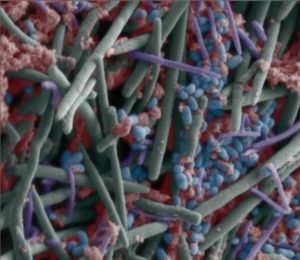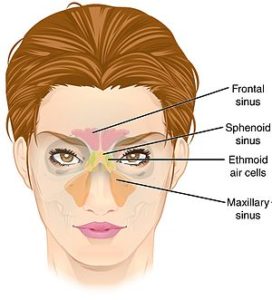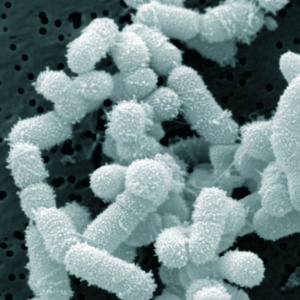
We all have millions of microbes living in our sinuses – bacteria, viruses, and fungi. This is normal.
An amazing fact is that living together are beneficial, benign, and what we normally consider harmful microbes. And this is normal. This rich and diverse community of microbes living in the sinuses is called the sinus microbiome or microbiota.
OUR SINUSES: We have 4 pairs of sinuses in our heads, which are air-filled and lined with a mucus membrane with cilia. The cilia steadily beat (700 to 800 times a minute!) in order to move mucous into the nasal cavity. Microbes live in the mucous lining.

Credit: Nat. Library of Medicine
For years it was thought that the sinuses were sterile, and a sinus infection meant that a harmful microbe (pathogen) had invaded. In the 1990s a popular view was that fungi were the cause of chronic sinusitis. But with the development of new technologies (genetic sequencing) in the last 2 decades, it was discovered that millions of all sorts of microbes live in the sinuses in both healthy and sick persons. And yes, that it was normal to have fungi in the sinuses (so that theory was dropped).
THE CURRENT VIEW: Millions of microbes live in complex communities, interact with one another, and with us (we’re their host!). In healthy persons all the microbial species are in equilibrium, and potentially harmful species are kept in check. But sometimes the communities can become disrupted and imbalanced – this is called dysbiosis.
When there is disruption (e.g., from an infection, allergies), then there can be an overgrowth or a big increase in the potentially harmful microbes living in the sinuses. This can make you more susceptible to an infection or it can result in sinusitis symptoms. (In chronic sinusitis there is an imbalanced sinus microbiome and also inflammation of the sinus mucous lining.)

A HEALTHY SINUS MICROBIOME: It turns out that what is a healthy sinus microbiome varies from person to person. Yes, there is a “core” sinus microbiome of species that are shared throughout the world. (For example: Corynebacterium and Staphylococcus species)
Everyone’s sinus microbiome is unique – you may have more of some species, less or none of others. Generally a heathy sinus microbiome has more richness of species and diversity, which is diminished in people with chronic sinusitis.
But guess what? Even if a person has fewer or more species – the total number of bacteria present is the same. Think of it this way – if there is an empty space, microbes will move in to occupy it.
A big surprise in the last 2 decades is that healthy sinuses have low levels of harmful microbes (e.g. Staphylococcus aureus) coexisting with beneficial microbes. They are considered to be “opportunistic pathogens”, which means they can become harmful if the conditions are right. For example, if the sinus microbial community becomes disrupted by an infection. Which is why so many people develop sinusitis after a cold or other respiratory infection.
Most research has looked at the multitudes of bacterial species living in our sinuses. But there are also species of viruses and fungi, and much is still unknown about them. The viruses (our “virome”) can be a stable part of our microbial community or only there briefly. Healthy persons (and those with sinusitis) also have fungi living in the sinuses.
In addition, some people have archaea living in their sinuses – one-celled organisms that don’t have a cell nucleus. A minority of people have archaea in their sinuses, but it is unknown why they are there, what is their role (if any), and why only some people have them. They can also be found in the human gut.
It turns out that we all (both healthy and sick) have biofilms living on the mucus lining of the sinuses. However, research suggests that they may be a little different in healthy persons – they are smaller (microcolonies), don’t cause an inflammatory response, and are kept in check by the other microbes. (Biofilms are bacteria communities sticking to one another, and with a protective slime coating.)
 Some microbes have an important role in the health of the sinus microbiome, even if they are there only in tiny amounts – these are keystone bacteria. Lactobacillus sakei is one of them (in Lanto Sinus), and research shows it is depleted in persons with chronic sinusitis.
Some microbes have an important role in the health of the sinus microbiome, even if they are there only in tiny amounts – these are keystone bacteria. Lactobacillus sakei is one of them (in Lanto Sinus), and research shows it is depleted in persons with chronic sinusitis.
What else influences the species of microbes in the sinus microbiome? The list includes illnesses, allergies, asthma, cigarette smoking, age of the person, antibiotics, and whether sinus surgery has been done. All these factors help explain why in both health and sickness, every person’s sinus microbiome is unique.
Bottom line: We have trillions of microbes living in our bodies, and this includes the sinus microbiome. The microbes living in our sinuses are bacteria, viruses, fungi, and for some people also archaea. The field is still in its infancy and so we still have much to learn.
[Originally posted May 28,2021 as Microbes Live In Our Sinuses. Updated June 16, 2023]
